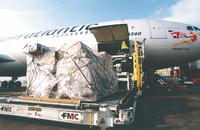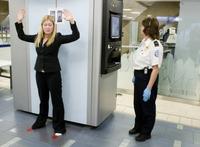-
Airports, carriers face additional costs as a result of 100 percent cargo inspections
On 1 August, 100 percent of air cargo carried on passenger planes in the United States must be screened for explosives and other illicit materials before the cargo is placed on the plane; this is up from the current level of 75 percent; DHS has already said it would not meet this deadline, but carriers are worried about the added cost nonetheless: electronic screening equipment is expensive, with some units costing as much as several hundred thousand dollars
-
-
Breakthrough: day of terahertz remote sensing nears
Terahertz (THz) wave technology, has great potential for homeland security and military uses because it can “see through” clothing and packaging materials and can identify immediately the unique THz “fingerprints” of any hidden materials; a major breakthrough opens the way for detecting hidden explosives, chemical, biological agents, and illegal drugs from a distance of twenty meters
-
-
TSA will miss 1 August air cargo screening deadline

TSA will miss the congressionally mandated 1 August deadline of having 100 percent of cargo carried on planes screened; all cargo loaded onto passenger planes departing from domestic airports will be checked for explosives by the deadline, but screening all international cargo entering the United States has proved more challenging; the reason: an estimated 2.8 billion pounds of air cargo arrives in the United States every year on passenger aircraft from 94 different countries; the cargo is handled in the global air cargo supply chain by a vast number of participants; each of these 94 countries has unique air cargo security programs and regulatory requirements, many of which differ significantly from those required by TSA
-
-
The number of incidents of lasers being flashed into aircraft rises sharply; federal, state prosecutors respond
The number of incidents of lasers being flashed into aircraft has risen steadily in the past five years — from 283 cases reported to the FAA nationwide in 2005 to 1,476 incidents last year; studies have supported pilots’ reports that bright external lights can cause a flare in the goggles pilots wear, temporarily impairing sight; a laser beam hitting the eyes of a pilot who does not wear goggles may cause temporarily blindness and disorientation; as ever-cheaper lasers have made their way into ever-more hands, federal and local prosecutors have picked up the pace of criminal cases; in many cases, the prosecution uses the Patriot Act, which include a provision about deliberately interfering with the pilot of an airplane or “mass transportation vehicle” with reckless disregard for human safety
-
-
Attacks on trains: what the numbers say
Terrorists see public surface transportation as a killing field; despite their continuing obsession with attacking commercial aviation, when it comes to wholesale killing, trains and buses offer easily accessible concentrations of people
-
-
Defending U.S. civilian aircraft against shoulder-fired missile may cost $43 billion
Equipping U.S. passenger aircraft with defenses against shoulder-fired missiles may cost $43.3 billion over twenty years, DHS says in an unpublished report; airlines say the expense exceeds the risk, and oppose installing the systems — or, if such installation is made mandatory, than the government should pay for it
-
-
Scientists: Full-body scanners' radiation underestimated, could pose cancer risk
More and more scientists express their unease with the amount of radiation to which passengers are exposed as they are screened by full-body scanners at airports; experts say radiation from the scanners has been underestimated and could be particularly risky for children; they say that the low level beam does deliver a small dose of radiation to the body, but because the beam concentrates on the skin — one of the most radiation-sensitive organs of the human body — that dose may be up to 20 times higher than first estimated
-
-
Airport security is big business, and Rapiscan Systems benefits
Airport security is serious business and, increasingly, it is also big business; TSA plans to deploy as many as 1,800 full-body scanner at U.S. airports by the end of 2014; at $170,000 a scanner, this is a $300 million proposition
-
-
Schumer pushing for new airport security scanning device
New York senator claims new scanner, produced by a Long Island-based company, would have prevented Shahzad from getting past no-fly list; the new scanning device would cross check passengers, weed-out fake IDs, and track visa overstays
-
-
6-year-old Ohio girl on DHS's terror watch list
A 6-year old Ohio girl made to go through secondary screening at Cleveland airport before being allowed on board because her name was on TSA’s terror watch list; the family contacted DHS, and the 6-year old received a letter from the department which would neither confirm nor deny any information they have about her
-
-
TSA looks for commercial software to manage Secure Flight
Managing the long — very long — No Fly and Terror Watch lists is not a simple task; TSA is looking to purchase commercial software to help manage its Secure Flight program which checks the information airlines collect about passengers against DHS terrorist watch lists
-
-
GAO: TSA is yet to conduct risk assessments for U.S. transportation systems
GAO criticizes TSA for taking its time conducting comprehensive risk assessments across the transportation sectors it is responsible for securing; according to the GAO, DHS still does not use a comprehensive risk management framework to secure intermodal facilities across aviation and surface transportation sectors
-
-
EU supports full-body scanners, but says common standards for privacy, health are needed

An EC report says that full-body scanning at airports makes a contribution to security, but that a common framework must be developed across the European Union to protect citizens’ fundamental rights and health
-
-
Hi-tech navies protect shipping from Somalia's pirates
The six ship EU force and other Western-led forces patrolling the Gulf of Aden have disrupted fifty-nine pirate groups in April and May alone; some naval forces in the region concentrate on escorting convoys of their own national vessels, while the Western-led forces spread themselves across the region saying they want to protect all shipping regardless of flag
-
-
Who is to blame for delays in installing surveillance cameras in NYC?
The project of installing surveillance cameras in New York subways was meant to be completed by Lockheed martin by August 2008; now, nearly two years later, the best-case scenario is completion (by a company or companies other than Lockheed) of a scaled-back electronic security system by some time in 2012; Lockheed Martin, NYC blame — and sue — each other for contract violations
-
More headlines
The long view
Calls Grow for U.S. to Counter Chinese Control, Influence in Western Ports
Experts say Washington should consider buying back some ports, offer incentives to allies to decouple from China.
